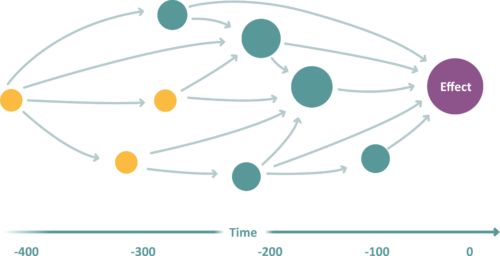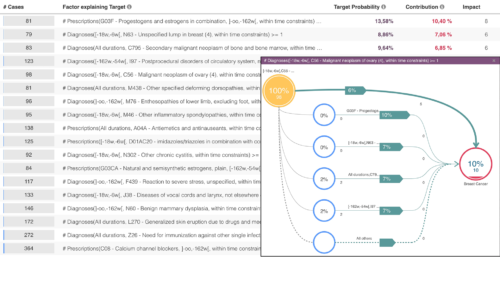What it can do for you
The CausalDiscoverer (XCD) is a groundbreaking tool that delves into the intricate web of causality within complex data. By rigorously eliminating all potential confounding factors, the XCD reveals the true relationship between two pivotal events, distinguishing the cause from the effect.
Harnessing the Power of Causality
In a data-driven world, understanding causality provides companies with profound insights into their operations, customer behaviors, and market dynamics. Armed with these insights, organizations can chart a course toward effective actions and make data-driven decisions that drive growth and ensure success.
Revolutionizing Data Analysis
The CausalDiscoverer introduces a paradigm shift in data analysis by focusing on analyzing objects holistically across all linked data streams originating from the root object. Unlike classical Data Warehouse (DWH) approaches that often necessitate data replication into “star schemas” or “OLAP cubes,” the XCD offers a panoramic view of your data landscape, providing a more comprehensive perspective, due to ObjectAnalytics.
Liberating Analytics from Constraints
With the XCD, you bid farewell to the days of relying on experts to fit data into restrictive analytical schemas. This transformative approach brings analytics out of the ivory tower and into the everyday fabric of your business operations. It empowers you to traverse your analytical journey interactively, from initial inquiries to probing follow-up
How the integration into your development environment looks like
The CausalDiscoverer offers a wide range of interfaces to meet your specific analytical needs. Whether it’s generating artifacts within the XCD, creating a relative time axis, or converting your session into a Python script or Jupyter notebook, this tool simplifies complex data analysis and expands your analytical capabilities.
Seamless Python Integration
At a time when Python has emerged as the preeminent language for data analysis and machine learning, the Xplain CausalDiscoverer effortlessly bridges the gap between causal exploration and your Python environment. It allows you to view artifact definitions as Python code and seamlessly integrate them into your scripts, enhancing your analytical workflow with remarkable ease. This integration unlocks the full potential of your data analysis so you can make informed decisions with confidence.
Example from manufacturing – cylinder heads production: analysis of the production process and root cause analysis in the case of faulty parts.
Why causality is important
Predictive modeling is a powerful tool capable of foretelling when a machine is about to fail. But to truly understand and address the problem, we need to dig deeper.
Unlock the “Why” with Causal Discovery
While predictive modeling can identify impending failures, it often leaves us with two critical questions: “Why is it failing?” and “What can I do about it?” This is where the journey of predictive modeling ends and the realm of Causal Discovery begins.
The Power of Causality: Shaping a Data-Driven Future
Causal Discovery takes us beyond simply predicting events. It’s a journey that uncovers the root causes, the “why” behind events. Only by understanding the underlying causes of a problem can we develop precise strategies and targeted interventions, whether it’s to eliminate the sources of failure or to achieve a desired outcome.
Understanding cause-and-effect relationships is the foundation upon which intelligent strategies are built to achieve any goal. Whatever your business objective, understanding what is critical to your success-or, conversely, what could lead to failure-is essential.
This understanding of causality empowers you to shape your future, prevent undesirable outcomes, and steer toward desired results. In essence, it’s the key to proactive, data-driven decision-making that can transform your business landscape.
The challenge – and our solution
In Real World Data there are literally “billions” of correlations to your target variable (your business goal). However, 99.9 % of them are meaningless. “Correlation does not equal Causation” – a well-known fact. But why is it so?
Distinguishing Correlation from Causation
And how can we penetrate that fog of correlations to see the real causes driving your business?
Confounders (factors that affect both the supposed cause and the supposed effect) mask the “real” impact of a factor on the outcome. Understanding cause and effect based on observational data primarily means finding these confounding factors. Thus, a wealth of information is required to avoid overlooking important confounding factors – and technology that can search such necessarily complex data for confounding factors.
Unveiling Hidden Factors with Causal Discovery Technology
Based on our ObjectAnalytics Database, our Causal Discovery approach is currently the only approach that can handle the complexity of “Real World Data” – and at the same time use the wealth of information in such data for a deep search for confounders. Without an experiment, this is still not proof of causality. However, Causal Discovery can sort out myriads of meaningless correlations, helping you quickly arrive at relevant hypotheses about causal effects.
Listen to Paula to understand our Causal Discovery approach on an intuitive level.
What Causal Discovery can be deployed for
Typical applications are:
Manufacturing
Optimize production with RCA: understand complex production processes and why manufactured parts are not meeting quality targets. Results: reduced downtime, lower scrap & rework rates, increased efficiency and thoughtput. Deploy Causal algorithms “in the loop”: the autonomous DiscoveryBot works in the background, continuously scanning the accumulating production data for emerging issues and root causes that threaten the production line.
Maintain an installed base of machines
Understand why machines fail and develop an intelligent maintenance strategy. Let artificial intelligence look for new problems and their causes and predict failures to intervene early.
Healthcare & Pharma
Understanding the causes of noncompliance and treatment changes. Recognize early signals of side effects. Understand who is at risk and why – and establish targeted care management.
CRM
Comprehend the causes of churn. Constantly look for new causes and how competitors are attacking your customer base. Measure the causal effectiveness of your campaigns.
… and many more.
What our Causal Discovery algorithms look like in practice
The Causal AI algorithms are embedded in the CausalDiscoverer and its interactive usability concept. Once configured, you simply click on a target and see what is driving or potentially causing that target. The domain expert can reject certain factors and ask for alternatives. This allows you to get results that combine knowledge from data with domain expertise.
Each of these algorithms can also be used in a Python environment.
DiscoveryBot
The autonomous Xplain Causal DiscoveryBot constantly monitors your processes for emerging issues and causes that jeopardize your production line or other business processes. Your insurance against unpleasant surprises.




